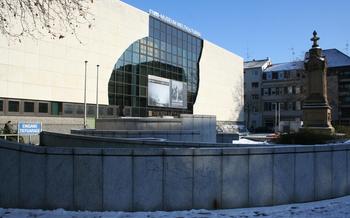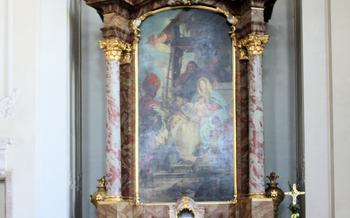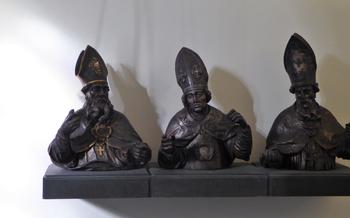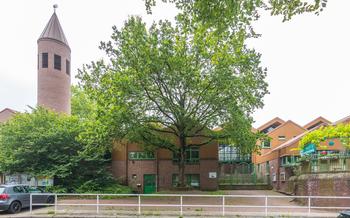
Jesuit Church Mannheim
- The Emblem of Mannheim
- A Journey Through Time: The History of the Jesuit Church
- Unveiling the Facade: A Masterpiece of Baroque
- Stepping Inside: A Sanctuary of Grandeur
- The Altar: A Symphony of Art and Devotion
- The Side Altars: Hidden Gems of Spirituality
- The Pulpit: A Platform of Eloquence
- The Organ: A Symphony of Sacred Sounds
- The Tombs: Whispers from the Past
- The Crypt: A Journey Beneath the Church
- The Tower: A Beacon of Faith
- The Gardens: A Haven of Serenity
- Events and Celebrations: A Living Legacy
- The Jesuit Community: Keepers of the Faith
- Insider Tip: Discovering Hidden Treasures
The Emblem of Mannheim
The Jesuit Church Mannheim, or Jesuitenkirche as it is locally known, stands as an iconic landmark of the city. Its distinctive Baroque architecture and impressive facade have earned it the distinction of being the emblem of Mannheim. The church's construction began in 1733 and was completed in 1760, showcasing the architectural prowess of the renowned architect Nicolas de Pigage. Its grand facade boasts an elegant harmony of curves and straight lines, adorned with intricate sculptures and carvings that depict biblical scenes and symbols. The harmonious interplay of light and shadow adds depth and drama to the facade, creating a visually stunning masterpiece.
The church's interior is equally awe-inspiring, featuring an impressive nave with soaring vaults, intricate ceiling frescoes, and vibrant stained glass windows. The Baroque embellishments throughout the church, including the ornate altars, pulpit, and organ, contribute to its rich and opulent atmosphere. The Jesuit Church Mannheim serves as a testament to the artistic and spiritual heritage of the city, attracting visitors from around the world who come to marvel at its architectural grandeur and immerse themselves in its sacred ambiance.
A Journey Through Time: The History of the Jesuit Church
The foundation of the Jesuit Church in Mannheim dates back to 1731, when the Jesuit Order, renowned for its educational and missionary work, established a presence in the city. The construction of the church was initiated under the patronage of Elector Carl Philipp of the Palatinate, who entrusted the design to the renowned architect Johann Baptist Neumann. Neumann, a master of the Baroque style, infused the church's architecture with his signature blend of grandeur, elegance, and intricate ornamentation.
The church's construction faced several challenges, including the outbreak of the War of the Austrian Succession in 1740, which halted progress for several years. Despite these setbacks, the church was eventually completed in 1756, standing as a testament to the perseverance and dedication of the Jesuit Order.
The Jesuit Church played a pivotal role in the religious and cultural life of Mannheim during the Baroque period. The Jesuits, known for their emphasis on education, established a grammar school and a college within the church complex. These institutions provided the city's youth with a comprehensive education, encompassing theology, philosophy, and the arts.
In the 19th century, the Jesuit Order was expelled from Mannheim, and the church came under the administration of the Catholic Diocese of Speyer. Despite this change in leadership, the church retained its significance as a center of worship and spirituality for the local community.
During World War II, the Jesuit Church suffered extensive damage akibat the Allied bombings. Much of the church's interior, including the magnificent ceiling frescoes, was destroyed. After the war, a meticulous restoration project was undertaken, and the church was painstakingly rebuilt to its former glory. Today, the Jesuit Church stands as a testament to the resilience of faith and the power of restoration.
Unveiling the Facade: A Masterpiece of Baroque
As you approach the Jesuit Church, its grand facade will captivate your attention. The entrance, adorned with intricate carvings and sculptures, invites you into a world of Baroque splendor. The interplay of light and shadow creates a dramatic effect, highlighting the architectural details and enhancing the overall grandeur of the church.
The intricate sculptures adorning the facade tell stories from the Bible and the lives of saints. Each figure is meticulously crafted, showcasing the skill and artistry of the Baroque period. The interplay of light and shadow brings these sculptures to life, creating a sense of movement and depth that draws you into their narratives.
The harmonious arrangement of architectural elements contributes to the overall visual impact of the facade. The use of pilasters, cornices, and pediments creates a sense of order and balance, while the curves and scrolls add a touch of dynamism and elegance. The result is a facade that is both imposing and inviting, a true masterpiece of Baroque architecture.
Stepping Inside: A Sanctuary of Grandeur
As you cross the threshold of the Jesuit Church, prepare to be enveloped by an aura of grandeur that transcends time. The nave, the central artery of the church, unfolds before you, its soaring height and expansive proportions creating a sense of awe and reverence. The intricate ceiling frescoes, a testament to the artistry of the Baroque era, draw your gaze upwards, inviting you to contemplate the celestial realms. The vibrant stained glass windows, casting a kaleidoscope of colors onto the marble floors, illuminate the sacred space, transforming it into a sanctuary of light and devotion. Baroque embellishments, with their characteristic flourishes and intricate details, adorn every nook and cranny, creating a harmonious visual symphony that captivates the senses.
The Altar: A Symphony of Art and Devotion
At the heart of the Jesuit Church Mannheim stands the majestic altar, a masterpiece of Baroque artistry that draws the eyes of all who enter. The central altarpiece, a stunning work of art, takes center stage, depicting biblical scenes with intricate carvings and vibrant colors. The interplay of light and shadow adds depth and drama to the scene, creating a sense of awe and reverence.
The intricate carvings on the altar showcase the exceptional craftsmanship of the Baroque era. Every detail is meticulously rendered, from the flowing drapery of the figures to the delicate ornamentation that adorns the frame. The vivid colors used in the altarpiece bring the biblical scenes to life, creating a sense of realism that captivates the viewer.
The central figure of the altarpiece is Jesus Christ, depicted in a moment of triumph or serene contemplation. Surrounding him are a host of saints and angels, each with their unique iconography and symbolism. The interplay of colors and textures creates a sense of harmony and balance, drawing the viewer's attention to the central figure.
Beyond its aesthetic beauty, the altar holds profound religious significance. It serves as a focal point for worship, a place where the faithful gather to offer prayers and receive sacraments. The intricate carvings and vibrant colors serve as a reminder of the divine presence and the stories of faith and devotion that have unfolded within these walls.
The Side Altars: Hidden Gems of Spirituality
Adorning the interior of the Jesuit Church Mannheim, alongside the grand main altar, are several smaller side altars, each dedicated to a different patron saint. These altars serve as hidden gems of spirituality, offering visitors a glimpse into the rich history and artistic prowess of the church.
Crafted with intricate iconography and symbolism, these side altars are a testament to the artistic craftsmanship of their time. Each altar features unique sculptures, paintings, and carvings, depicting the lives and stories of the saints they honor. The vibrant colors and textures of these altars create a sense of awe and wonder, inviting visitors to explore the depths of their religious significance.
The side altars provide a sense of intimacy and personal connection with the divine. Visitors can pause to reflect on the virtues and examples of the saints, seeking guidance and inspiration in their own spiritual journeys. The altars serve as a testament to the power of faith and the enduring devotion of the Jesuit community.
The Pulpit: A Platform of Eloquence
Positioned prominently within the Jesuit Church Mannheim, the pulpit stands as a testament to the power of oratory and the dissemination of religious teachings. Its intricate wood carvings, each stroke imbued with profound symbolism, narrate tales of faith, hope, and redemption. The pulpit's elevated position signifies the authority and importance of the spoken word, a platform from which religious leaders have imparted wisdom and guidance to generations of worshippers.
The pulpit's design reflects the prevailing Baroque style, characterized by its intricate ornamentation and dynamic forms. The intricate carvings depict scenes from the Bible, allegorical figures, and symbols of the Catholic faith. These intricate details serve as visual aids, helping to illustrate and reinforce the messages conveyed from the pulpit.
Throughout history, the pulpit has played a pivotal role in shaping the spiritual lives of Mannheim's Catholic community. From its inception, the church has served as a center for religious instruction, with sermons and teachings delivered from this sacred platform. The eloquence and fervor of the speakers have left an enduring mark on the hearts and minds of the faithful.
Practical Considerations: - Visitors are welcome to admire the pulpit during regular church hours. - While photography is permitted, it is essential to be respectful of ongoing services or events. - Guided tours of the church, including the pulpit, are available upon request and offer a deeper understanding of its history and significance.
The Organ: A Symphony of Sacred Sounds
In the heart of the Jesuit Church Mannheim, a magnificent organ stands as a testament to the power of sacred music. Its history is intertwined with the church's own story, dating back to the 18th century when the renowned organ builder Johann Andreas Silbermann crafted this masterpiece. With its intricate carvings and gilded pipes, the organ becomes a focal point of the church's interior, captivating the eyes and ears of visitors.
The organ's architectural integration is a testament to its importance within the church. It occupies a prominent position above the choir loft, commanding attention with its sheer size and grandeur. The intricate carvings that adorn the organ case depict scenes from the Bible, adding a layer of visual storytelling to the musical experience. The gilded pipes, shimmering in the light, create a sense of awe and reverence.
The organ's musical prowess is equally impressive. Its powerful sound resonates throughout the church, filling the sacred space with heavenly melodies. Renowned organists have graced the keys of this instrument, offering concerts that showcase the organ's versatility and range. The acoustics of the church, with its high ceilings and reflective surfaces, enhance the organ's sound, creating a truly immersive musical experience.
For visitors who wish to experience the organ's grandeur firsthand, attending a concert is highly recommended. The church regularly hosts organ concerts featuring talented musicians who bring the instrument to life. The programs often include classical masterpieces, as well as contemporary compositions that showcase the organ's diverse capabilities. Concertgoers can immerse themselves in the music, allowing its beauty and power to transport them to a realm of spiritual transcendence.
The Tombs: Whispers from the Past
Interspersed among the ornate chapels and vibrant stained glass windows of the Jesuit Church Mannheim lie several tombs, each whispering tales of notable figures who once graced this sacred space. These final resting places, adorned with intricate carvings, epitaphs, and symbolism, offer a glimpse into the lives and legacies of those who contributed to the church's rich history.
One of the most prominent tombs belongs to Friedrich Karl von Schönborn, a prince-elector of Mainz and a significant benefactor of the church. His elaborate tomb features a life-sized effigy of the prince, adorned with intricate details and symbols of his power and authority. The epitaph, etched in Latin, extols his virtues and accomplishments, immortalizing his memory within the walls of the Jesuit Church.
Another notable tomb is that of Johann Wilhelm von Pfalz-Neuburg, the founder of Mannheim. His resting place, situated near the main altar, is a testament to his role in shaping the city's destiny. The tomb's design, featuring a majestic sculpture of the prince, reflects his grandeur and the deep respect accorded to him by the community.
These tombs, with their historical significance and artistic merit, serve as poignant reminders of the lives that have intersected with the Jesuit Church Mannheim. They invite visitors to pause, reflect, and appreciate the enduring legacies of those who have left an indelible mark on the church's story.
The Crypt: A Journey Beneath the Church
Venturing beneath the hallowed grounds of the Jesuit Church, one discovers a hidden realm steeped in history and spirituality—the crypt. This subterranean sanctuary serves as the final resting place for notable figures who have left an indelible mark on Mannheim's religious and cultural landscape.
Descending into the crypt, visitors are greeted by an atmosphere of reverence and tranquility. Rows of stone sarcophagi and ornate tombs line the dimly lit corridors, each bearing witness to the lives and legacies of the departed. Intricate carvings, epitaphs, and coats of arms adorn these final resting places, narrating the stories of those who once walked the streets of Mannheim.
Among the most notable burials in the crypt is that of Friedrich Spee, a Jesuit priest, and renowned poet who fearlessly spoke out against the witch trials of the 17th century. His tomb, adorned with a poignant epitaph, stands as a reminder of his unwavering commitment to justice and compassion.
Another prominent figure entombed in the crypt is Johann Philipp von Stadion, the Prince-Bishop of Speyer, who played a pivotal role in the history of Mannheim. His elaborate tomb, crafted from marble and adorned with intricate carvings, reflects his status and influence during his lifetime.
Exploring the crypt is a journey through time, where visitors can pay their respects to those who have shaped Mannheim's rich heritage. It is a place of contemplation and remembrance, where the echoes of the past resonate amidst the silence of the present.
The Tower: A Beacon of Faith
Soaring high above the city skyline, the tower of the Jesuit Church stands as a proud symbol of faith and resilience. This magnificent structure, completed in 1760, has stood witness to the passage of time and the trials and tribulations of Mannheim's history. Its octagonal shape and intricate Baroque ornamentation set it apart from the surrounding cityscape, making it a true architectural gem.
Ascend the winding staircase that leads to the tower's viewing platform, and you'll be rewarded with breathtaking panoramic vistas of Mannheim and its environs. Take in the sweeping views of the city's bustling streets, the tranquil waters of the Neckar River, and the lush greenery of the surrounding countryside. On a clear day, you can even catch a glimpse of the distant Odenwald Mountains.
Beyond its role as a vantage point, the tower also holds historical significance. During World War II, it served as an observation post for air raid wardens, who kept watch for enemy aircraft approaching the city. The scars of war are still visible on the tower's exterior, a poignant reminder of Mannheim's resilience in the face of adversity.
Today, the tower remains an integral part of the Jesuit Church, serving as a beacon of faith and a symbol of hope for the community. It is open to visitors during guided tours, offering a unique perspective on the church's history and architecture. Whether you're a history buff, an architecture enthusiast, or simply seeking a breathtaking view of Mannheim, the tower of the Jesuit Church is an unmissable attraction.
The Gardens: A Haven of Serenity
Complementing the grandeur of the Jesuit Church Mannheim, its idyllic gardens offer a tranquil oasis in the heart of the city. Steeped in history, these serene green spaces trace their origins back to the 18th century when they served as a contemplative retreat for the Jesuit community. Today, they remain a cherished sanctuary, inviting visitors to immerse themselves in nature's tranquility and find respite from the urban hustle and bustle.
Meticulously landscaped, the gardens showcase a harmonious blend of formal and informal elements. manicured lawns, vibrant flower beds, and towering trees create a picturesque tapestry that changes with the seasons. Visitors can wander along the winding paths, pause to admire the vibrant blooms, or simply relax on a bench beneath the shade of a majestic oak tree.
Beyond their aesthetic appeal, the gardens hold significant historical value. They were meticulously planned and designed by the Jesuits, who believed in the power of nature to inspire contemplation and spiritual growth. The gardens served as a place for the Jesuits to retreat, reflect, and connect with the natural world.
Today, the gardens remain a vital part of the Jesuit community, offering a tranquil setting for prayer, meditation, and reflection. They are also a popular destination for locals and tourists seeking a peaceful escape from the city's bustling streets. Visitors can explore the gardens at their own pace, discovering hidden corners and enjoying the serenity of this urban oasis.
Events and Celebrations: A Living Legacy
The Jesuit Church Mannheim is not merely a historical monument but also a vibrant center for religious and cultural events. Regular church services and masses are held, allowing visitors and locals alike to immerse themselves in the spiritual atmosphere of this sacred space.
Beyond religious observances, the church hosts a variety of special events and festivals throughout the year. These celebrations showcase the diverse cultural heritage of Mannheim and the surrounding region. From traditional German folk festivals to international music concerts, there is something for everyone to enjoy.
Music plays a significant role in the life of the Jesuit Church. The grand organ is not just a decorative element but an instrument that brings the church to life with its majestic sounds. Organ concerts and other musical performances are frequently held, offering visitors the opportunity to experience the church's acoustics and appreciate the talent of local musicians.
Practical information for attending events at the Jesuit Church Mannheim is readily available online or at the church office. Visitors are encouraged to check the church's website or contact the parish office for specific dates and times of events.
The Jesuit Community: Keepers of the Faith
The Jesuit Church in Mannheim is not merely a magnificent architectural edifice; it is also a living testament to the faith and dedication of the Jesuit community. The Jesuits, a Catholic religious order founded in the 16th century, have played a significant role in the history and development of Mannheim. They arrived in the city in the early 17th century and quickly established themselves as educators, scholars, and spiritual guides.
Throughout the centuries, the Jesuits have made significant contributions to the city's intellectual and cultural landscape. They founded the University of Mannheim, one of the oldest and most prestigious universities in Germany. They also established a renowned Jesuit school, which provided education to generations of young men from the region.
Today, the Jesuit community in Mannheim continues to be a vibrant and active presence. They lead the parish of the Jesuit Church, offering regular masses, spiritual guidance, and community outreach programs. They also run a variety of educational and cultural initiatives, including lectures, concerts, and exhibitions.
If you are fortunate enough to visit the Jesuit Church during your stay in Mannheim, take some time to connect with the Jesuit community. Attend a mass, participate in a guided tour, or simply strike up a conversation with one of the Jesuits. You will be inspired by their faith, their dedication, and their commitment to serving the community.
Insider Tip: Discovering Hidden Treasures
Secret Corners and Hidden Details: - Seek out the intricate carvings on the confessional booths, each telling a unique story. - Discover the hidden sacristy, a treasure trove of religious artifacts and vestments. - Look for the faint remnants of medieval frescoes beneath the Baroque layers, revealing the church's rich history.
Unique Perspectives and Angles for Photography: - Capture the church's grandeur from a bird's eye view by climbing the tower for panoramic shots. - Experiment with different angles to highlight the interplay of light and shadow on the facade. - Photograph the intricate details of the pulpit, capturing the craftsmanship and symbolism.
Off-the-Beaten-Path Experiences: - Attend a special mass or event to witness the church's vibrant community in action. - Join a guided tour to uncover hidden stories and anecdotes about the church's past. - Explore the surrounding Jesuit Quarter, with its charming streets and historical buildings.
Exploring the Surrounding Area: - Visit the Mannheim Palace, a Baroque masterpiece just a short walk from the church. - Stroll along the banks of the Neckar River, enjoying the picturesque views and lively atmosphere. - Discover the vibrant art and culture scene of Mannheim, with its museums, theaters, and galleries.









